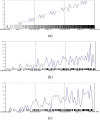Template-driven spatial-temporal outbreak simulation for outbreak detection evaluation
- PMID: 18999301
- PMCID: PMC2655995
Template-driven spatial-temporal outbreak simulation for outbreak detection evaluation
Abstract
We developed a non-disease specific template-driven spatial-temporal outbreak simulator for evaluating outbreak detection algorithms. With only a few outbreak parameter settings, our simulator can generate different patterns of outbreak cases either temporally or spatial-temporally using three different generation algorithms: deterministic, independent, Poisson process. Our simulator is flexible, easy to implement and provides case event times rather than aggregated counts. We provide examples of outbreak simulations using linear template functions. Our Template-Driven Simulator is a useful tool for evaluating of outbreak detection algorithms.
Figures


Similar articles
-
A multi-level spatial clustering algorithm for detection of disease outbreaks.AMIA Annu Symp Proc. 2008 Nov 6;2008:611-5. AMIA Annu Symp Proc. 2008. PMID: 18999304 Free PMC article.
-
Predicting outbreak detection in public health surveillance: quantitative analysis to enable evidence-based method selection.AMIA Annu Symp Proc. 2008 Nov 6;2008:76-80. AMIA Annu Symp Proc. 2008. PMID: 18999264 Free PMC article.
-
Algorithms for rapid outbreak detection: a research synthesis.J Biomed Inform. 2005 Apr;38(2):99-113. doi: 10.1016/j.jbi.2004.11.007. J Biomed Inform. 2005. PMID: 15797000
-
A review of back-calculation techniques and their potential to inform mitigation strategies with application to non-transmissible acute infectious diseases.J R Soc Interface. 2015 May 6;12(106):20150096. doi: 10.1098/rsif.2015.0096. J R Soc Interface. 2015. PMID: 25977955 Free PMC article. Review.
-
Outbreak detection through automated surveillance: a review of the determinants of detection.J Biomed Inform. 2007 Aug;40(4):370-9. doi: 10.1016/j.jbi.2006.09.003. Epub 2006 Oct 5. J Biomed Inform. 2007. PMID: 17095301 Review.
References
-
- Wong W-K, Moore AW. Classical time-series methods for biosurveillance. In: Wagner MM, Moore AW, Aryel RA, editors. Handbook of biosurveillance. New York: Academic Press; 2006. pp. 217–234.
-
- Lawson AB, Kleinman K, editors. Spatial & syndromic surveillance for public health. West Sussex: John Wiley & Sons; 2005. pp. 1–269.
-
- Hogan WR, Cooper GC, Wallstrom GL, Wagner MM, Depinay JM. The Bayesian aerosol release detector. Stat Med. 2007;26(29):5225–52. - PubMed
-
- Watkins RE, Eagleson S, Beckett S, Garner G, Veenendaal B, Wright G, Plant A. Using GIS to create synthetic disease outbreaks. BMC Medical Informatics and Decision Making. 2007;7:4. Available from: http://www.biomedcentral.com/1472-6947/7/4. - PMC - PubMed
Publication types
MeSH terms
Grants and funding
LinkOut - more resources
Full Text Sources
Medical
